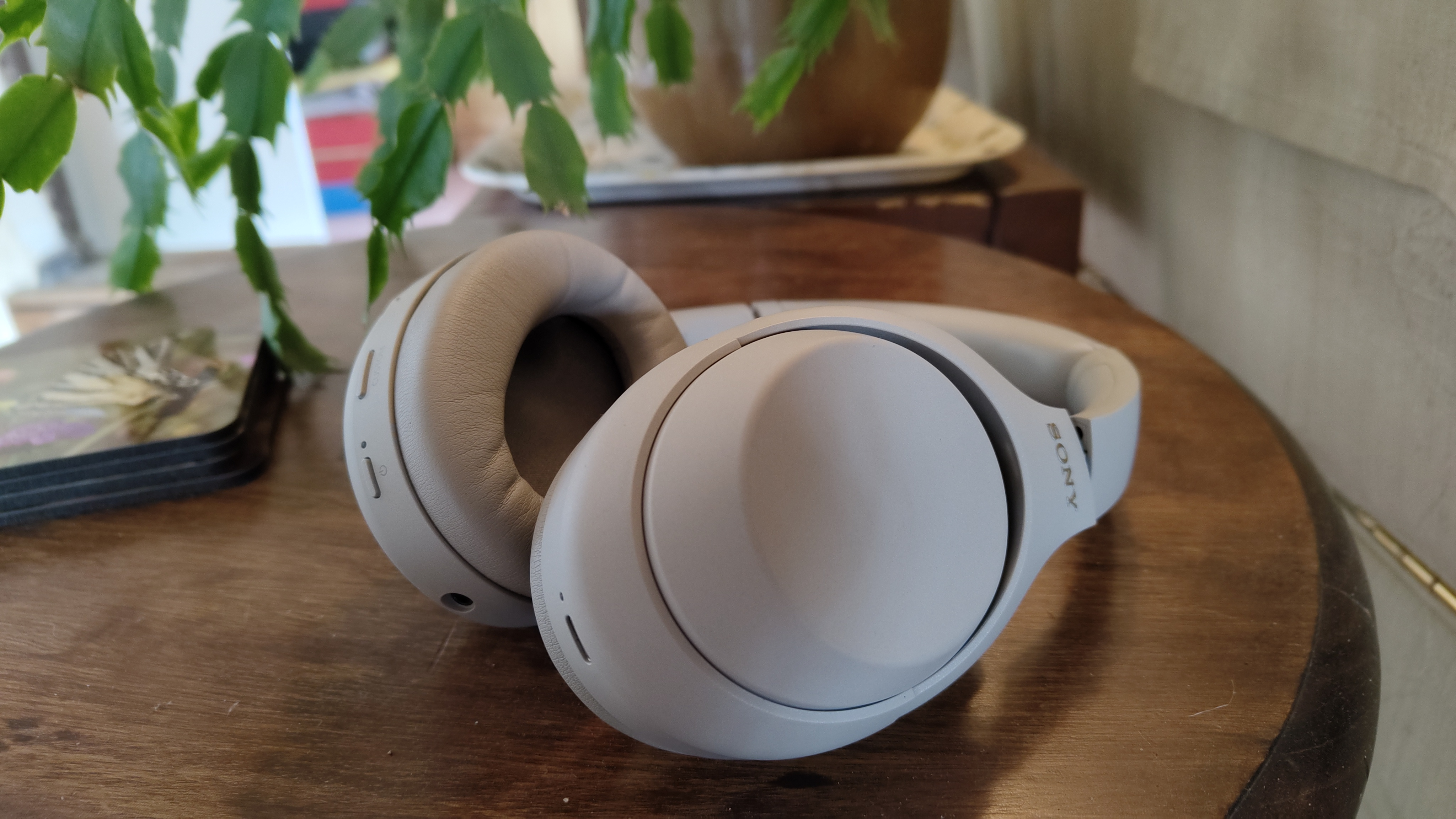What Hi-Fi? Verdict
The W2720i’s combination of living room-friendly smarts and home cinema-friendly picture quality is seriously hard to resist
Pros
- +
Excellent all-round picture quality
- +
Unusually effective integrated smart system
- +
Good value
Cons
- -
Minor whiteouts in HDR peaks
- -
Average built-in sound system
- -
No Game preset
Why you can trust What Hi-Fi?
Projector type LED-lit DLP
Screen size up to 300 inches (claimed)
Native resolution 4K (via DLP XPR technology)
Input lag 17.8ms (60Hz)
HDR support HLG, HDR10, HDR10+
Dimensions 14 x 42 x 31cm
Weight 6.5kg
At first glance, the BenQ W2720i looks as though it could be a tough sell.
Its built-in sound system, auto set-up, unusual AI-bolstered performance enhancements and Google TV smart platform make it look like a casual living-room projector. Yet its relatively high price, Filmmaker Mode, 2500 lumens of claimed peak light output and the fact that it has been fully calibrated before shipping make it look like a serious home theatre projector.
Meanwhile, its support for 120Hz feeds and a Fast mode for reducing input lag even get you wondering if it’s another one of BenQ’s dedicated gaming projectors.
The more you use the W2720i, though, the less it looks like a projector with an identity crisis and the more it looks like one of the finest projector all-rounders we have ever seen.
Price
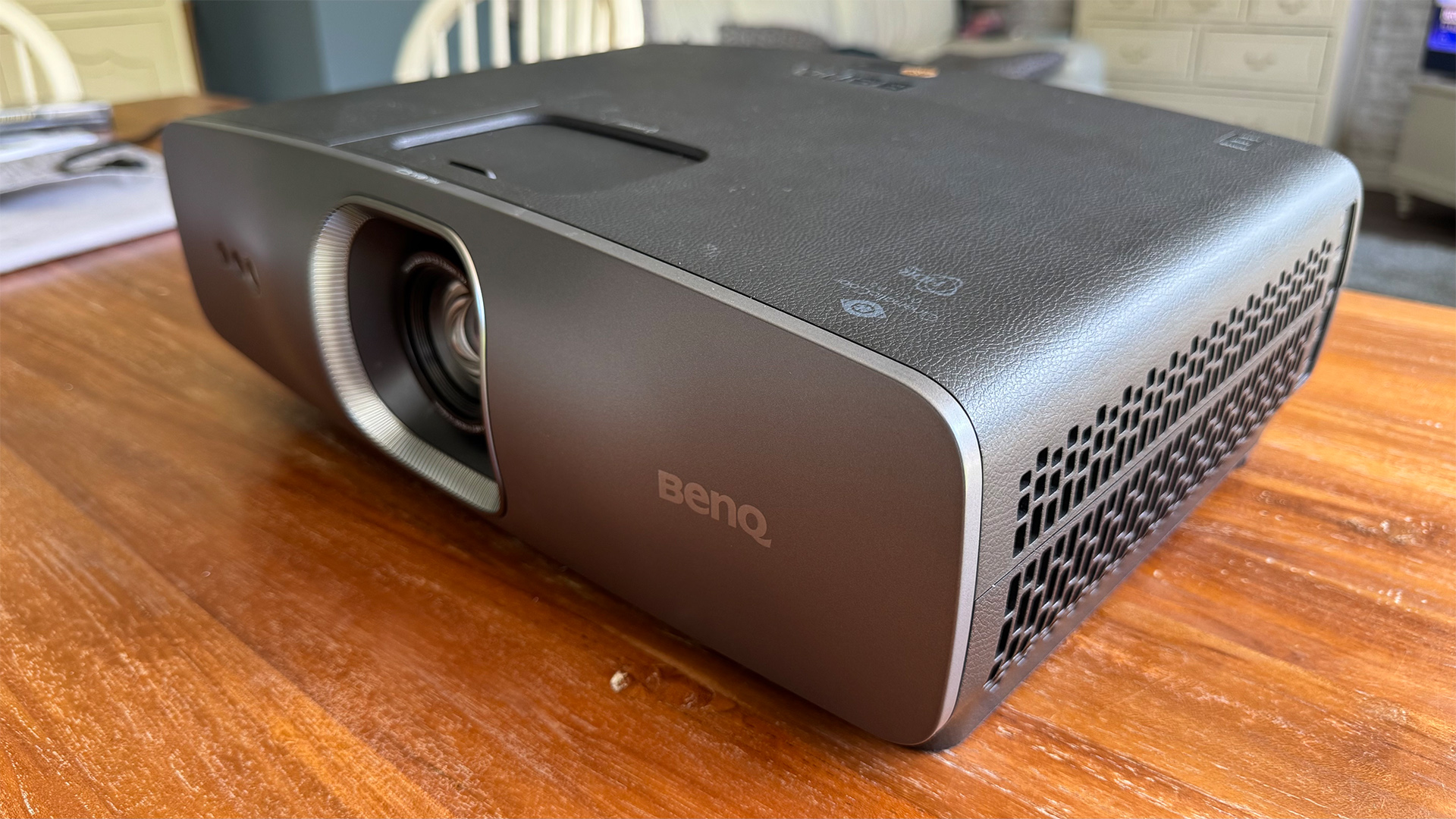
On one hand, the BenQ W2720i’s £1999 / $2599 / AU$3299 price tag looks a little high for a projector which, in some ways at least, gives off a casual living-room vibe.
On the other hand, though, some of its specifications and features make the W2720i start to look a much more serious proposition than it first appears, to the point where its price actually starts to look like quite a bargain. Provided, of course, that its performance lives up to its on-paper promise.
The W2720i’s unusual positioning, with feet in two usually separate projector camps, makes direct competition hard to find. Based on price more than anything else, though, we should mention BenQ’s own X3100i and the Hisense C1.
The latest hi-fi, home cinema and tech news, reviews, buying advice and deals, direct to your inbox.
The X3100i is a cute cube-shaped projector with a focus on gaming that also happens to excel with video, while the C1 is a really likeable living-room projector with good picture and (unusually) sound quality tucked inside a lovely metallic blue cubic design.
Design
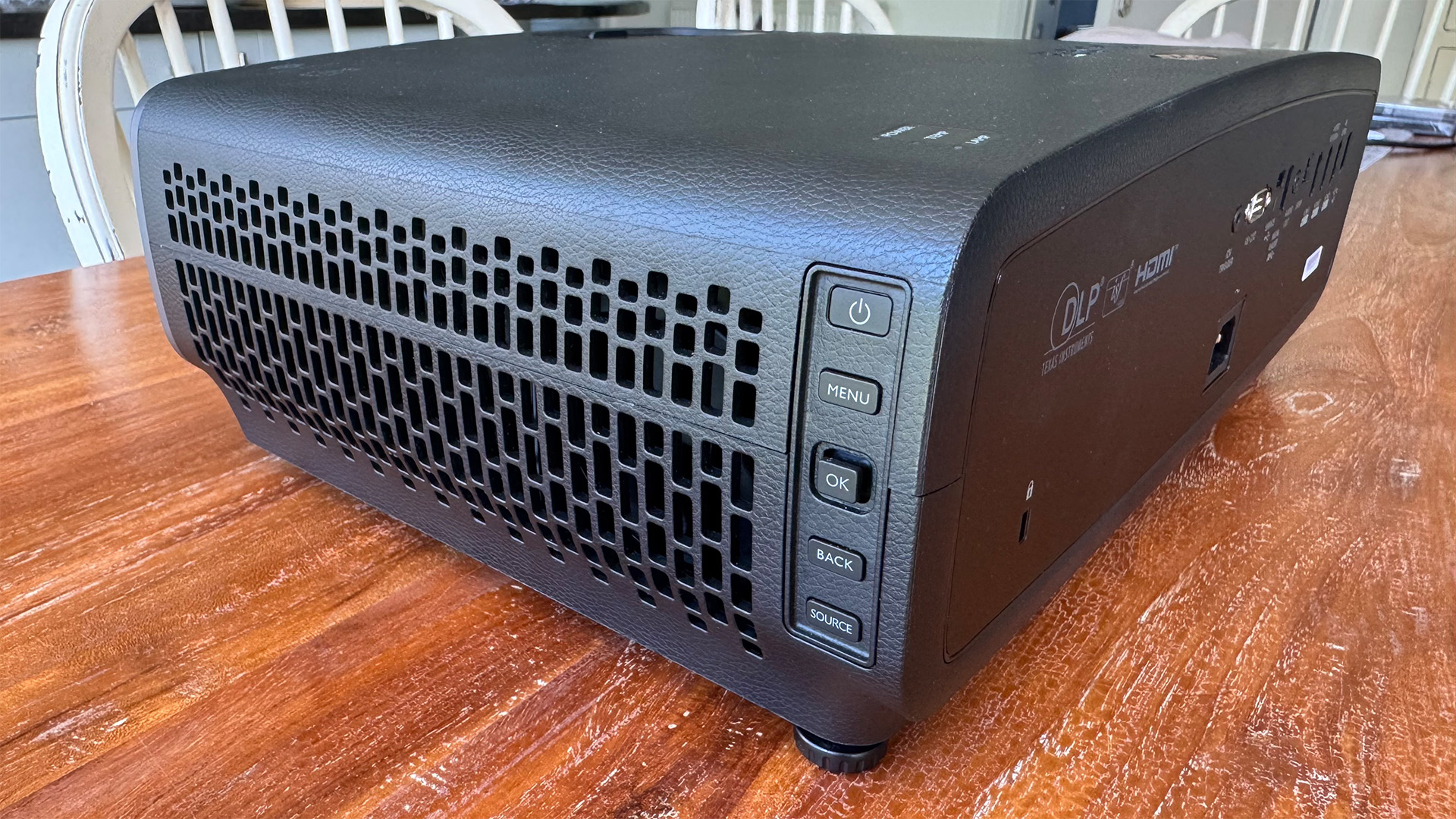
While a fair bit larger than your average casual ‘coffee table’ projector, the W2720i is still quite pretty by projector standards.
Its edges are all nicely rounded off, its top edge enjoys a comely curve that further softens the projector’s presence, and the promisingly substantial, centrally placed lens is tucked within a neat recess adorned with silvery strip highlights.
Its smooth matt grey finish looks and feels more premium than those wrapped around many living room projectors, too.
The remote control that BenQ provides with the W2720i is equally attractive, thanks to a nicely rounded shape that sits comfortably in your hand, a premium white gloss finish, and a logical, spacious button layout.
The buttons are backlit, too, to make them easier to find in a dark movie-night environment.
Features
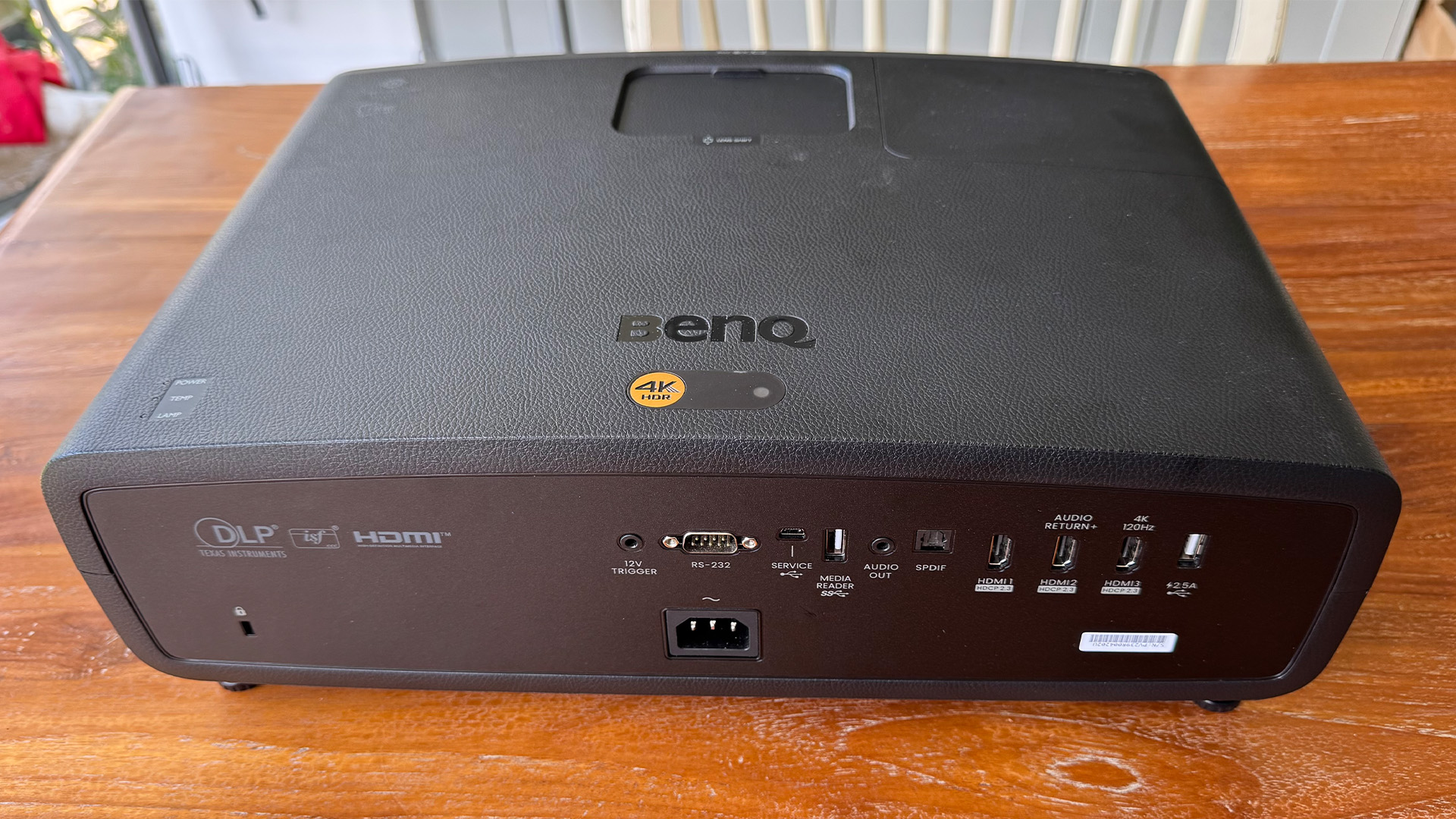
This is where the W2720i starts to get really interesting, mixing as it does features and specifications that would normally be found only shared across different projector types.
Its optics are built around a DLP system, illuminated by LED lamps claimed to deliver 30,000 hours of use without replacement. That’s enough for around 15,000 movies – or one movie every day for 40 years – unless you happen to be obsessed with Titanic and Killers Of The Flower Moon, anyway.
The LED lighting delivers up to a claimed 2500 lumens of peak brightness and a promising claimed dynamic contrast ratio of 2,000,000:1, while colour coverage is stated to achieve 90 per cent of the DCI-P3 HDR spectrum and 98 per cent of the Rec 709 SDR spectrum.
In keeping with BenQ’s more overtly home theatre-targeted projectors, the W2720i has been calibrated for accuracy in BenQ’s factory before shipping, with a certificate of calibration included in the box.
Fans of relatively accurate, ‘serious’ movie viewing experiences will also be pleased to hear that the W2720i carries a Filmmaker Mode designed to deliver images that stay true to the main established image standards.
The W2720i’s connections go further than those of most projectors by including three HDMIs, one of which provides ARC support for passing sound – including Dolby Atmos tracks – out to a connected AVR or soundbar, and one of which supports 4K/120Hz feeds (though not VRR) from a PlayStation 5, Xbox Series X or suitably capable PC graphics cards.
Given the game-friendly nature of one of the HDMIs, though, it’s a pity that the W2720i doesn’t provide a dedicated Game mode as a shortcut to the projector’s most responsive settings.
There is a ‘Fast’ picture option that reduces the time the projector takes to render images, but when you select this it generates a message saying you also need to manually turn off a bunch of other features, including keystone correction, noise reduction and the projector’s 4K sharpness enhancement, to get the fastest response out of the projector. Which only underlines the feeling that it would surely have been better if BenQ had just set up a Game preset with all these adjustments done for you.
Making BenQ’s thinking here even more strange is the fact that if you set your games console or PC to feed the W2720i a 4K/120Hz HDR feed, the projector suddenly decides that it can actually automatically turn its noise reduction and motion enhancer 4K features off for you.
Your reward for following the Fast mode instructions and going to the trouble of turning off as much of the projector’s image processing tools as possible is an input lag time of just 17.8ms – a great result by projector standards.
Other connections include two USBs (one offering 2.5A of power for, say, a video streaming ‘stick’, and one media reader); RS232C and 12V trigger ports help you integrate the projector into a home entertainment control system; plus 3.5mm and digital optical audio output alternatives to the eARC HDMI route. Though the W2720i does also carry its own built-in 2x5W stereo speaker system.

For cable haters, the W2720i supports wi-fi, Bluetooth, Apple AirPlay and Google Cast. The wi-fi option is particularly important here, as this feeds the video streaming apps the projector carries as part of its integrated Android TV smart system. The W2720i is far from the first projector to incorporate Android TV, but it does make a better fist of it than any other projector we have seen to date.
For one thing, its Android TV implementation runs reasonably slickly and stably during our tests, without the myriad bugs and app failures we see all too often in the smart projector space. Even better, all the key video apps seem actually to be nativised to the projector’s capabilities, rather than any of them serving up lower-quality generic feeds from basic open website portals.
Even the W2720i can’t, of course, suddenly overcome Android TV’s blind spot when it comes to some of the UK’s main broadcaster catch-up services. So there are no functioning BBC iPlayer, All4 or ITVX apps, for instance.
The likes of Amazon Prime Video, Apple TV, Disney Plus, Netflix, YouTube, Discovery+ and Paramount+ are all present and correct, though, which will quite likely be enough for many households. And you can always add a relatively cheap streaming stick to cover those missing apps.
The W2720i supports high dynamic range playback from both its built-in streaming apps and external sources, with HDR10+ support joining the basic HDR10 and HLG formats. There’s no Dolby Vision support, but getting even one of the premium HDR formats on a projector is still quite rare.
The W2720i’s HDR credentials are boosted, too, by an HDR Pro system designed continually to optimise HDR10 and HLG pictures to the projector’s capabilities – a bit like the HDR dynamic tone mapping systems that many TVs carry these days.
The set-up process for the W2720i features an unusual but helpful combination of automated and manual options.
An auto screen-fit system adjusts the picture to match the size of your screen, while an AI Cinema Mode can automatically adjust the picture based on analysis of both the content you’re watching and the tone and level of light in your room. But there are also manual vertical optical image shift and 8-point geometry correction tools, plus a reasonably helpful 1.3x level of optical zoom.
The attractive on-screen menus also provide access to a ‘Cinemaster’ suite of adjustments, containing Colour Enhancer, Pixel Enhancer 4K, Motion Enhancer 4K, Global Contrast Enhancer and Local Contrast Enhancer options. While you need to handle these options with care, they actually add up to quite a useful set of picture fine-tuning tools.
While content support for 3D continues to dwindle, finally, the W2720i still provides playback support – assuming you sort yourself out with the necessary BenQ 3D glasses, of course.
Picture quality

Any lingering doubts about the W2720i’s talents potentially falling awkwardly between casual and serious home theatre stools are quickly and emphatically put to bed when we finally sette down to see what it can do.
So many aspects of the W2720i’s pictures feel right, in fact, that it’s actually hard to break them down into their constituent elements. We instead keep finding ourselves just getting caught up in what we are watching. This is, of course, exactly the experience you want from a projector – but we guess you want a bit more detail than that from the supposed professionals. So, with a deep breath, here goes.
First up, the W2720i’s pictures are phenomenally sharp. We hear those people who say DLP projectors like the W2720i don’t deliver truly native 4K resolutions, relying instead on pixel-shifting/double flashing technology to achieve a ‘virtual’ 4K image. But so crisp, detailed, pristine and full of texture and density are the W2720i’s pictures that they really do look 4K, even if pushed to prodigious image sizes. Nor is there anything artificial about this sharpness; it feels entirely natural and organic rather than the result of any sort of aggressive processing.
The sharpness holds up even during 24p movie action scenes thanks to some strikingly natural, cinematic handling of judder with a provided 24P True Cinema setting in play.
The W2720i excels, too, with contrast. Many projectors struggle to strike a convincing balance between the sort of relatively high brightness that HDR sources depend on and the sort of convincing black colours needed to make dark HDR scenes look as convincing and compelling as bright ones. For the most part, though, the W2720i strikes an excellent balance, as bright scenes and image areas enjoy plenty of punch and some surprisingly intense small light ‘peaks’, while dark scenes usually avoid excessive grey clouding and still contain enough shadow details to share the same depth you get with bright shots.
Again, there is typically nothing artificial or forced about the W2720i’s compelling contrast, either. Dark scenes even manage to look consistently stable, without any distracting flickering issues, despite the best picture settings relying on a dynamic contrast system where brightness is continually adjusted to deliver the best results.
The W2720i’s colours continue the natural theme. An impeccable sense of balance, for instance, ensures that no tones look forced or stand out too much against the rest. The projector can cover enough of the DCI-P3 spectrum, too, to mean that even the most vibrant areas of colour don’t look ‘rolled off’ or off-key, and the subtleties of colour tone that BenQ’s projector can deliver ensure that blends look smooth while objects in the picture look solid and three-dimensional.
Skin tones are particularly well handled, too, avoiding both that plasticky look and the green/red/jaundiced tones they can take on with less talented projectors.
Despite its wealth of HDR-friendly features, the W2720i adapts extremely well to SDR sources, and expertly turns its hand to gaming once you have activated the Fast mode and turned off the projector’s video-processing features.
The W2720i’s impressive array of truly nativised video streaming apps contributes to the most consistently excellent streamed picture quality we have seen from a smart projector. The sharpness, cleanliness, contrast and colour balance it achieves with 4K HDR streams from every major streaming app (though especially Netflix) is always a joy to behold.
It’s hard to find negative things to say about the W2720i’s pictures in the context of its price point. There are brighter projectors out there that can push HDR harder, though the W2720i’s ability to deliver real intensity to HDR’s brightest highlights while also achieving natural-looking black levels actually makes its 2500 lumens of light feel pretty perfectly judged. So really our only fair complaints are that relatively large bright highlights of HDR pictures can lack a little subtle shading detail, especially in Filmmaker Mode, and that the projector’s usually convincing dark scenes can suddenly grey out momentarily if a mostly very dark shot suddenly features an extremely bright highlight.
Neither of these issues occurs often enough, though, to count as a remotely big deal in the context of everything the W2720i gets right.
Sound quality
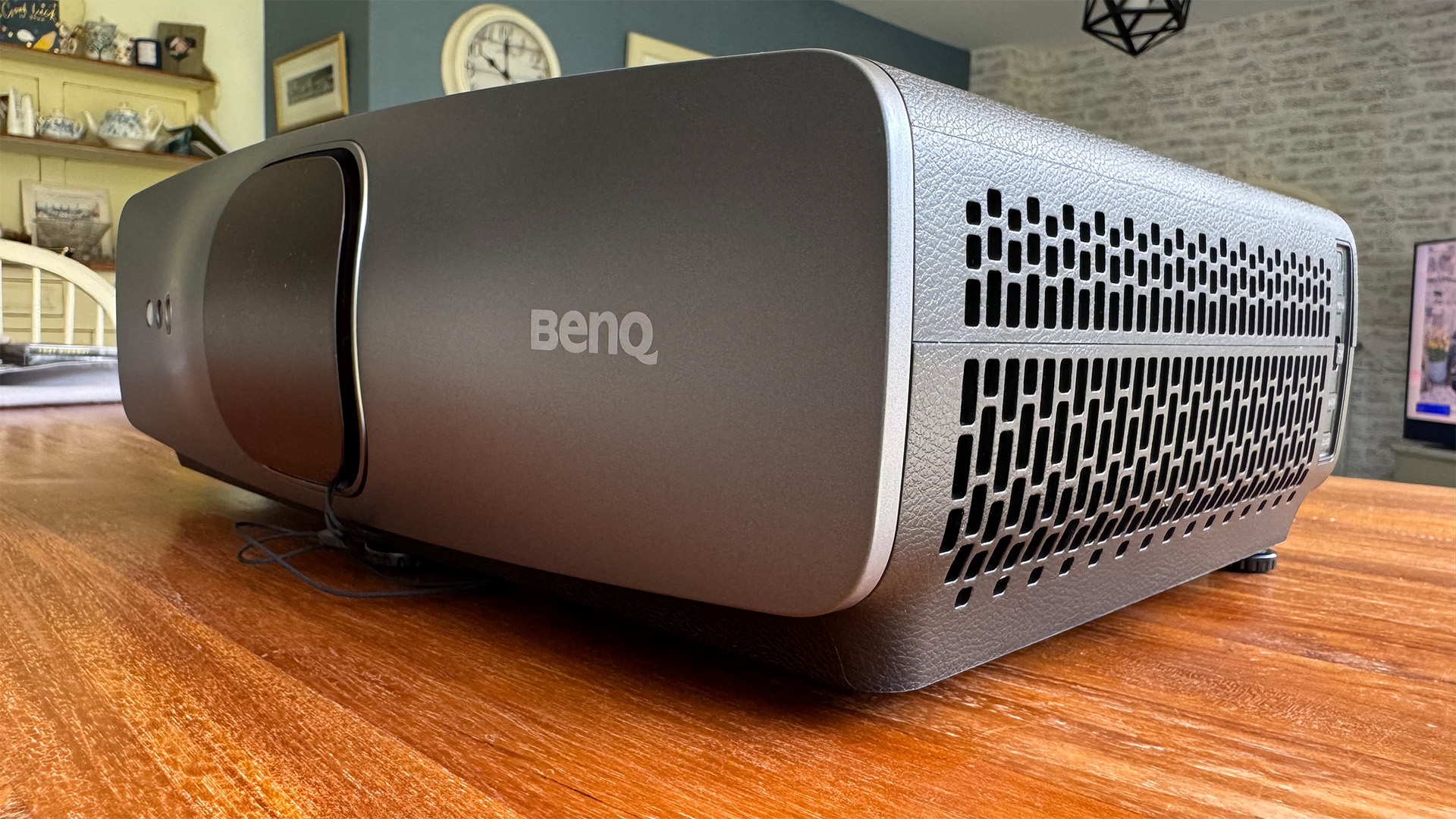
The W2720i’s built-in sound system isn’t exactly the most powerful we’ve heard. Even at maximum volume, the sound doesn’t get very loud at all, denying soundtracks anything like the sort of impact you want to go with the massive and punchy images the projector can provide.
It’s not all bad news, though. For one thing, the speakers can project dialogue, ambient effects and the sort of relatively trebly sounds that help good film soundtracks feel busy a decent distance away from the projector’s body.
This creates a larger sound stage than most projector sound systems manage, as well as making some of the sound seem to be coming from at least somewhere in the vicinity of the on-screen action.
Low-frequency sounds don’t escape the projector’s bodywork quite as readily, which can leave loud scenes sounding a bit dislocated.
There’s quite a nice tone to bass sounds, though, and while the speakers can’t get loud, they do at least avoid distortion and dropouts.
So, while you’ll want to find some sort of external audio solution for serious film nights, the W2720i can work OK as a standalone all-in-one solution for casual occasions.
Verdict

The W2720i does an outstanding job of straddling the usually incompatible worlds of serious and casual home cinema/home entertainment projection.
Indeed, this is a remarkable all-rounder that is more than good enough to make its asking price look like a steal.
SCORES
- Picture 5
- Sound 3
- Features 4
MORE:
Also consider the BenQ X3100i, Hisense C1 and Epson EH-TW7100
These are the best projectors you can buy right now
John Archer has written about TVs, projectors and other AV gear for, terrifyingly, nearly 30 years. Having started out with a brief but fun stint at Amiga Action magazine and then another brief, rather less fun stint working for Hansard in the Houses Of Parliament, he finally got into writing about AV kit properly at What Video and Home Cinema Choice magazines, eventually becoming Deputy Editor at the latter, before going freelance. As a freelancer John has covered AV technology for just about every tech magazine and website going, including Forbes, T3, TechRadar and Trusted Reviews. When not testing AV gear, John can usually be found gaming far more than is healthy for a middle-aged man, or at the gym trying and failing to make up for the amount of time he spends staring at screens.
You must confirm your public display name before commenting
Please logout and then login again, you will then be prompted to enter your display name.


